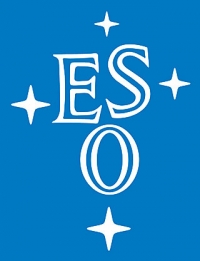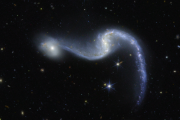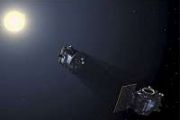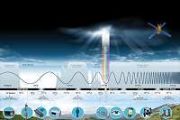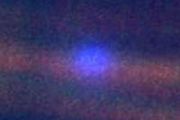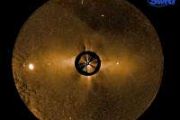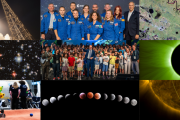European Southern Observatory, is the foremost intergovernmental astronomy organisation in Europe and the world's most productive astronomical observatory. ESO provides state-of-the-art research facilities to astronomers and is supported by Austria, Belgium, the Czech Republic, Denmark, Finland, France, Germany, Ireland, Italy, the Netherlands, Poland, Portugal, Spain, Sweden, Switzerland and the United Kingdom, along with the host state of Chile. Several other countries have expressed an interest in membership.
ESO, formally the European Organisation for Astronomical Research in the Southern Hemisphere, is usually known as The European Southern Observatory.
ESO's main mission, laid down in the 1962 Convention, is to provide state-of-the-art research facilities to astronomers and astrophysicists, allowing them to conduct front-line science in the best conditions. The annual Member State contributions to ESO are approximately 198 million euros and ESO employs around 700 staff members. By building and operating a suite of the world's most powerful ground-based astronomical telescopes enabling important scientific discoveries, ESO offers numerous possibilities for technology spin-off and transfer, together with high technology contract opportunities and is a dramatic showcase for European industry.
The ESO Headquarters (comprising the scientific, technical and administrative centre of the organisation) are located in Garching near Munich, Germany. In Chile, ESO operates the Vitacura centre as well as three unique observing sites: La Silla, Paranal and Chajnantor.
ESO is building the 39-metre Extremely Large Telescope, the ELT, which will become “the world’s biggest eye on the sky”.
Antennas of the Atacama Large Millimeter/submillimeter Array (ALMA), on the Chajnantor Plateau in the Chilean Andes. The Large and Small Magellanic Clouds, two companion galaxies to our own Milky Way galaxy, can be seen as bright smudges in the night sky, in the centre of the photograph.
Credit: ESO/C. Malin
ESO at a glance

Astronomy is often described as the oldest science and there can be no doubt that a view towards the majestic Milky Way band of stars — as it stretches across the sky on a clear night — must have been an awe-inspiring sight to people of all ages and cultures. Today, astronomy stands out as one of the most modern and dynamic sciences, using some of the most advanced technologies and sophisticated techniques available to scientists. And these are exciting times for astronomy: technology now allows us to study objects at the far edge of the Universe and to detect evidence for planets around other stars. We can begin to answer a fundamental question that fascinates every one of us: are we alone in the Universe?
The European Southern Observatory (ESO) is the pre-eminent intergovernmental science and technology organisation in astronomy. It carries out an ambitious programme focused on the design, construction and operation of powerful ground-based observing facilities for astronomy, in order to enable important scientific discoveries. ESO also plays a leading role in promoting and organising cooperation in astronomical research.
ESO operates three unique world-class observing sites in the Atacama Desert region of Chile: La Silla, Paranal and Chajnantor. ESO's first site is at La Silla, a 2400 m high mountain 600 km north of Santiago de Chile. It is equipped with several optical telescopes with mirror diameters of up to 3.6 metres. The 3.5-metre New Technology Telescope broke new ground for telescope engineering and design and was the first in the world to have a computer-controlled main mirror, a technology developed at ESO and now applied to most of the world's current large telescopes. The ESO 3.6-metre telescope is now home to the world's foremost extrasolar planet hunter: HARPS (High Accuracy Radial velocity Planet Searcher), a spectrograph with unrivalled precision.
While La Silla remains at the forefront of astronomy, and is still the second most scientifically productive ground-based astronomical observatory, the 2600 m high Paranal site — home to the Very Large Telescope array (VLT) — is the flagship facility of European astronomy. Paranal is situated about 130 km south of Antofagasta in Chile, 12 km inland from the Pacific coast, in one of the driest areas of the world. Scientific operations began at Paranal in 1999 and have resulted in many extremely successful research programmes.
The VLT is a most unusual telescope which is based on the latest technology. It is not just one, but an array of four Unit Telescopes, each with a main mirror measuring 8.2 metres in diameter. With one Unit Telescope, images of celestial objects as faint as magnitude 30 have been obtained in a one-hour exposure. This corresponds to observing objects that are four billion times fainter than those seen with the naked eye.
The VLT also has four additional 1.8-metre moveable Auxiliary Telescopes. One of the most exciting features of the VLT is the option to use it as a giant optical interferometer (VLT Interferometer or VLTI). This is done by combining the light from several of either the Unit Telescopes or the Auxiliary Telescopes. In this interferometric mode, the telescope has a vision equivalent to that of a single telescope the size of the separation between the most distant mirrors. For the VLTI using the Auxiliary Telescopes, this distance can be up to 200 metres.
Each year, about 2000 research proposals are made for the use of ESO telescopes, requesting between four and six times more nights than are available. ESO is the most productive astronomical observatory in the world, and annually results in many peer-reviewed publications: in 2013 alone, over 840 refereed papers based on ESO data were published. Moreover, research articles based on VLT data are in the mean quoted twice as often as the average. The very high efficiency of ESO's "science machines" now generates huge amounts of data at a very high rate. Data are stored in a permanent Science Archive Facility at ESO Headquarters. The archive now contains more than 1.5 million images or spectra with a total volume of about 65 terabytes (65 000 000 000 000 bytes) of data. This corresponds to the content of about 30 million books of 1000 pages each; they would occupy more than 1000 kilometres of bookshelves!
The Atacama Large Millimeter/submillimeter Array (ALMA), the largest ground-based astronomy project in existence, is a revolutionary facility for world astronomy. ALMA is comprised of an array of 66 giant 12-metre and 7-metre diameter antennas observing at millimetre and submillimetre wavelengths. ALMA started scientific observations in 2011 and was inaugurated in 2013. ALMA is located on the high altitude Llano de Chajnantor, at 5000 m elevation, making it one of the highest astronomical observatory sites in the world. ALMA is a partnership between ESO (representing its Member States), NSF (USA) and NINS (Japan), together with NRC (Canada), NSC and ASIAA (Taiwan), and KASI (South Korea), in cooperation with the Republic of Chile. The Joint ALMA Observatory is operated by ESO, AUI/NRAO and NAOJ.
The Chajnantor site is also home to the 12-metre APEX millimetre and submillimetre telescope, operated by ESO on behalf of the Onsala Space Observatory, the Max Planck Institute for Radio Astronomy and ESO itself.
The next step beyond the VLT is to build the Extremely Large Telescope (ELT) with a 39-metre primary mirror. The ELT will be "the world's biggest eye on the sky" — the largest optical/near-infrared telescope in the world. The ELT will address many of the most pressing unsolved questions in astronomy. It may, eventually, revolutionise our perception of the Universe, much as Galileo's telescope did 400 years ago. The green light for ELT construction was given in late 2014, with technical first light planned for 2025.
The ESO Headquarters are located in Garching, near Munich, Germany. This is the scientific, technical and administrative centre of ESO where technical development programmes are carried out to provide the observatories with the most advanced instruments.
Organisational Structure
ESO, the European Southern Observatory (or formally the European Organisation for Astronomical Research in the Southern Hemisphere), is an intergovernmental organisation with 16 Member States along with the host state of Chile and with Australia as a strategic partner.
The organisation is led by the Director General who is appointed by the ESO Council. The current Director General is Prof. Xavier Barcons.
The main organisational and managerial units of ESO are the Directorates. The Directorates are: Directorate of Programmes, Directorate of Operations, Directorate for Science, Directorate of Administration and Directorate of Engineering. They are organised either in Programmes, in Divisions and/or Departments, some of which consist of two or more Groups.
Member Nations
The European Southern Observatory (ESO) is an intergovernmental organisation with 16 Member States*. These Member States are:
Country |
Formally joined |
Member number |
2017 Scale all MS = 100 (%) * |
Total 2017 MS Contributions in kEUR |
More info |
ESON mini-site |
| Austria | 2009 | 14 | 2.31 | 4,110 | ESO & Austria | Austria |
| Belgium | 1967 | Founding member | 2.87 | 5,094 | Belgium | |
| Czech Republic | 2007 | 13 | 1.02 | 1,809 | ESO & Czech Republic | Czech Republic |
| Denmark | 1967 | 6 | 1.91 | 3,408 | ESO & Denmark | Denmark |
| Finland | 2004 | 11 | 1.42 | 2,512 | ESO & Finland | Finland |
| France | 1964 | Founding member | 15.00 | 26,701 | France | |
| Germany | 1964 | Founding member | 22.08 | 39,295 | Germany | |
| Ireland | 2018 | 16 | 1.27 | 2,266 | ESO & Ireland | Ireland |
| Italy | 1982 | 8 | 11.08 | 19,709 | ESO & Italy | Italy |
| Netherlands | 1964 | Founding member | 4.85 | 8,626 | ESO & Netherlands | Netherlands |
| Poland | 2015 | 15 | 2.98 | 5,305 | ESO & Poland | Poland |
| Portugal | 2001 | 9 | 1.17 | 2,072 | Portugal | |
| Spain | 2007 | 12 | 7.55 | 13,439 | Spain | |
| Sweden | 1964 | Founding member | 2.85 | 5,077 | ESO & Sweden | Sweden |
| Switzerland | 1982 | 7 | 4.42 | 7,870 | ESO & Switzerland | Switzerland |
| United Kingdom | 2002 | 10 | 17.22 | 30,636 | ESO & UK | UK |
| Total 162,445 |
|
|||||
*Australia is a Strategic Partner. Brazil has signed the accession agreement, but not yet ratified it.

